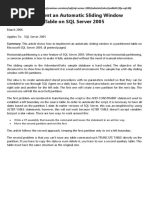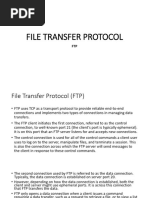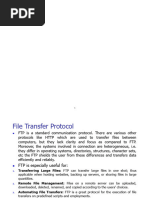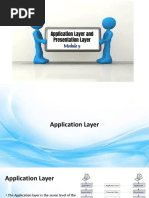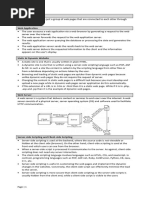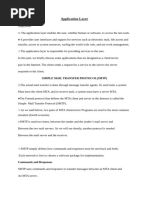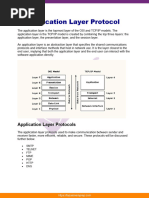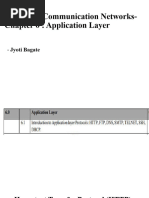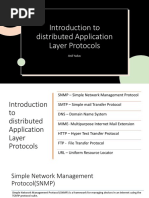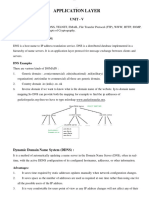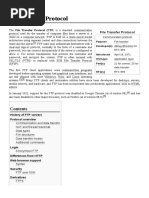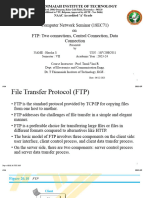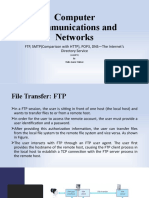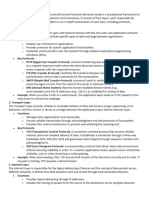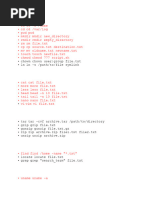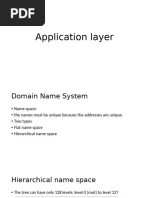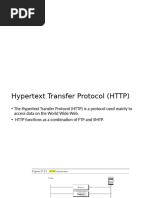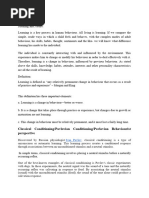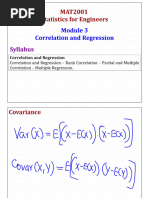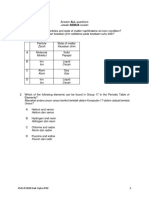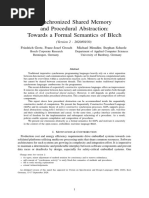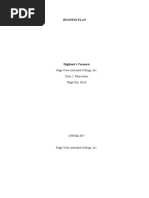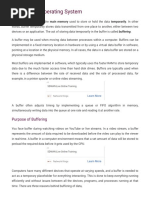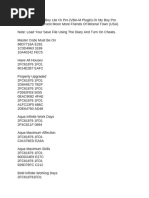0 ratings0% found this document useful (0 votes)
3 views28-FTP-14-11-2024
28-FTP-14-11-2024
Uploaded by
abhissunita763ftp
Copyright:
© All Rights Reserved
Available Formats
Download as PPTX, PDF, TXT or read online from Scribd
28-FTP-14-11-2024
28-FTP-14-11-2024
Uploaded by
abhissunita7630 ratings0% found this document useful (0 votes)
3 views11 pagesftp
Copyright
© © All Rights Reserved
Available Formats
PPTX, PDF, TXT or read online from Scribd
Share this document
Did you find this document useful?
Is this content inappropriate?
ftp
Copyright:
© All Rights Reserved
Available Formats
Download as PPTX, PDF, TXT or read online from Scribd
Download as pptx, pdf, or txt
0 ratings0% found this document useful (0 votes)
3 views11 pages28-FTP-14-11-2024
28-FTP-14-11-2024
Uploaded by
abhissunita763ftp
Copyright:
© All Rights Reserved
Available Formats
Download as PPTX, PDF, TXT or read online from Scribd
Download as pptx, pdf, or txt
You are on page 1of 11
File Transfer Protocol
File Transfer Protocol
• File Transfer Protocol (FTP) is the standard mechanism provided by
TCP/IP for copying a file from one host to another.
• Differs from other client/server applications in that it establishes two
connections between the hosts. One connection is used for data
transfer, the other for control information (commands and
responses).
Communication over Control
Connection
• FTP uses the same approach as SMTP to communicate across the
control connection. It uses the 7-bit ASCII character set.
• Communication is achieved through commands and responses. This
simple method is adequate for the control connection because we
send one command (or response) at a time.
• Each command or response is only one short line, so we need not
worry about file format or file structure.
• Each line is terminated with a two-character (carriage return and line
feed) end-of-line token
Communication over Data
Connection
• file transfer in FTP means one of three things:
• o A file is to be copied from the server to the client. This is called
retrieving aft/e. It is done under the supervision of the RETR command.
• o A file is to be copied from the client to the server. This is called
storing aft/e. It is done under the supervision of the STOR command.
• o A list of directory or file names is to be sent from the server to the
client. This is done under the supervision of the LIST command. Note
that FTP treats a list of directory or file names as a file. It is sent over
the data connection.
File Type
• FTP can transfer one of the following file types across the data
connection: an ASCII file, EBCDIC file, or image file.
• The ASCII file is the default format for transferring text files. Each
character is encoded using 7-bit ASCII. The sender transforms the file
from its own representation into ASCII characters, and the receiver
transforms the ASCII characters to its own representation.
• If one or both ends of the connection use EBCDIC encoding (the file
format used by IBM), the file can be transferred using EBCDIC
encoding.
• The image file is the default format for transferring binary files.
Data Structure
• FTP can transfer a file across the data connection by using one of the
following interpretations about the structure of the data:
• file structure, record structure, and page structure.
• In the file structure format, the file is a continuous stream of bytes. In
the record structure, the file is divided into records.
• This can be used only with text files.
• In the page structure, the file is divided into pages, with each page
having a page number and a page header.
• The pages can be stored and accessed randomly or sequentially.
Transmission Mode
• FTP can transfer a file across the data connection by using one of the
following three transmission modes:
• stream mode,
• block mode, and
• compressed mode.
• The stream mode is the default mode. Data are delivered from FTP to
TCP as a continuous stream of bytes.
• If the data are divided into records (record structure), each record will
have a I-byte end of-record (EOR) character and the end of the file will
have a I-byte end-of-file (EOF) character. In block mode, data can be
delivered from FTP to TCP in blocks. In this case, each block is preceded
by a 3-byte header. The first byte is called the block descriptor; the next
2 bytes define the size of the block in bytes.
• In the compressed mode, if the file is big, the data can be compressed.
The compression method normally used is run-length encoding. In a
binary file, null characters are usually compressed
You might also like
- ETS GRE PowerPrep Plus Paid Tests Questions Forrggwgwg Test 3 160 Questions McElroy TutoringDocument1 pageETS GRE PowerPrep Plus Paid Tests Questions Forrggwgwg Test 3 160 Questions McElroy TutoringtashfiqueNo ratings yet
- Blockchain Unconfirmed Transaction Hack ScriptDocument4 pagesBlockchain Unconfirmed Transaction Hack ScriptMoshoodNo ratings yet
- Microsoft - How To Implement Automatic Sliding Window in Partitioned TableDocument6 pagesMicrosoft - How To Implement Automatic Sliding Window in Partitioned Tablesivy75No ratings yet
- FTP - 100549Document28 pagesFTP - 100549athulkav2003No ratings yet
- Data Communication & Networking Data Communication & NetworkingDocument49 pagesData Communication & Networking Data Communication & NetworkingMuhammad Inzmam KulachiNo ratings yet
- ReportDocument24 pagesReportJennifer GriffinNo ratings yet
- Chapter14 FTPDocument29 pagesChapter14 FTPqcvjmjtdptxscmtbzfNo ratings yet
- Unit 5.1 FTP PDFDocument8 pagesUnit 5.1 FTP PDFSUMIT PANDEYNo ratings yet
- K. SalahDocument19 pagesK. SalahHari HaraanNo ratings yet
- Appln - FTPDocument14 pagesAppln - FTPLena DevarajNo ratings yet
- Telnet: Discuss Telnet in DetailDocument27 pagesTelnet: Discuss Telnet in DetailJayaprasannaNo ratings yet
- FTPDocument4 pagesFTPspartansheikNo ratings yet
- File Transfer Protocol: Protocol: A System of Fixed RulesDocument10 pagesFile Transfer Protocol: Protocol: A System of Fixed Ruleslalit KumarNo ratings yet
- File Transfer Protocol (FTP) in Application LayerDocument5 pagesFile Transfer Protocol (FTP) in Application LayerJitendra RaiNo ratings yet
- CN-2-viksDocument18 pagesCN-2-viksmi ka SanguNo ratings yet
- CN - Unit 5 NotesDocument24 pagesCN - Unit 5 Notes99210041290No ratings yet
- FTP XXDocument13 pagesFTP XXDaniel MekuryawNo ratings yet
- 34 ApplicationsDocument48 pages34 ApplicationsImam JabarNo ratings yet
- FTP AssignmentDocument15 pagesFTP AssignmentmannanciitNo ratings yet
- Module 5 Application and Presentation LayerDocument156 pagesModule 5 Application and Presentation LayerAnsariNo ratings yet
- U5 FTPDocument12 pagesU5 FTPDr.W.Regis Anne - PSGCTNo ratings yet
- Web System & Technologies NotesDocument15 pagesWeb System & Technologies Notestanzilalatif143No ratings yet
- Networking AssignmentsDocument10 pagesNetworking AssignmentswangariabeNo ratings yet
- Application Layer Protocol Gate Notes 72Document5 pagesApplication Layer Protocol Gate Notes 72manoj kumarNo ratings yet
- File Transfer ProtocolDocument14 pagesFile Transfer ProtocolDhrubobiswas749 BiswasNo ratings yet
- FTP File Transfer Protocol: Reference: RFC 959Document15 pagesFTP File Transfer Protocol: Reference: RFC 959api-3706009No ratings yet
- Chapter - 10Document36 pagesChapter - 10Sindhu official radhakrishnNo ratings yet
- File Transfer ProtocolDocument11 pagesFile Transfer ProtocolCasana UapNo ratings yet
- CN 5 AsDocument25 pagesCN 5 Asriman7278No ratings yet
- File Transfer Protocol (FTP) : Control ConnectionDocument10 pagesFile Transfer Protocol (FTP) : Control ConnectionNeal BreslerNo ratings yet
- 6 Marks in Question BankDocument22 pages6 Marks in Question BankPRIYAM XEROXNo ratings yet
- Presentation1 TomorrowDocument76 pagesPresentation1 TomorrowiotcsiotNo ratings yet
- New CCN - Chapter 6 - R2019Document126 pagesNew CCN - Chapter 6 - R2019normaluse2405No ratings yet
- Inter Process CommunicationDocument17 pagesInter Process CommunicationArun KumarNo ratings yet
- IT AssignmentDocument4 pagesIT AssignmentIdrees BharatNo ratings yet
- Lecture 5 - TCP-IP protocolsDocument21 pagesLecture 5 - TCP-IP protocolsmungai.allanNo ratings yet
- Presentation NetworkingDocument20 pagesPresentation NetworkingMuhammad Inzmam KulachiNo ratings yet
- ProtocolsDocument2 pagesProtocolsxiler12988No ratings yet
- 5 2 (HTTP&FTP)Document10 pages5 2 (HTTP&FTP)sparthsalunkeNo ratings yet
- FTP - File Transfer Protocol: NotesDocument16 pagesFTP - File Transfer Protocol: NotesChidambaramNo ratings yet
- Ibrahiem Elbarki FTPDocument18 pagesIbrahiem Elbarki FTPAhmed AboubakrNo ratings yet
- Introduction To Distribucted Application Layer ProtocolsDocument6 pagesIntroduction To Distribucted Application Layer ProtocolsAnil yadavNo ratings yet
- Lecture 3Document42 pagesLecture 3Hassan allaNo ratings yet
- Cs3591cn Unit I (Part 2)Document56 pagesCs3591cn Unit I (Part 2)hod cseNo ratings yet
- Applc TRNSPT NW LAyersDocument29 pagesApplc TRNSPT NW LAyersa NaniNo ratings yet
- Network ProtocolsDocument13 pagesNetwork ProtocolspallaB ghoshNo ratings yet
- Computer Networks (1) - 157-172Document16 pagesComputer Networks (1) - 157-172Harini VelrajNo ratings yet
- Data TransferDocument17 pagesData TransferMasele YusufNo ratings yet
- Files Unit 3 PDFDocument13 pagesFiles Unit 3 PDFaNo ratings yet
- Lecture 3Document32 pagesLecture 3jasmhmyd205No ratings yet
- FTP Imp RCDocument48 pagesFTP Imp RCKarthik KeyanNo ratings yet
- File Transfer Protocol (Aug. 12, 1973) RFC 542 NIC 17759Document42 pagesFile Transfer Protocol (Aug. 12, 1973) RFC 542 NIC 17759elracoNo ratings yet
- CN Unit 5Document20 pagesCN Unit 5chatkall46No ratings yet
- 3Document8 pages3Akash GuptaNo ratings yet
- 14.1-Protocol-Notes-By-EMK-2024Document8 pages14.1-Protocol-Notes-By-EMK-2024Florence DzoroNo ratings yet
- Open System Interconnection Model (OSI)Document38 pagesOpen System Interconnection Model (OSI)SvetlanaNo ratings yet
- Computer Network Chapter 4Document45 pagesComputer Network Chapter 4mawdodi.sadamNo ratings yet
- File Transfer ProtocolDocument11 pagesFile Transfer ProtocolYuvaraj BhaduryNo ratings yet
- Computer Network Seminar (18EC71) On FTP: Two Connections, Control Connection, Data ConnectionDocument12 pagesComputer Network Seminar (18EC71) On FTP: Two Connections, Control Connection, Data ConnectionHarsha SNo ratings yet
- Computer Communications and Networks: FTP, SMTP (Comparison With HTTP), POP3, DNS-The Internet's Directory ServiceDocument30 pagesComputer Communications and Networks: FTP, SMTP (Comparison With HTTP), POP3, DNS-The Internet's Directory ServiceAbdullah AnwaarNo ratings yet
- Unit 1 CN TCPDocument2 pagesUnit 1 CN TCPtahi66438No ratings yet
- chapter-no-5 (1)Document28 pageschapter-no-5 (1)Ajinkya PawarNo ratings yet
- Hacking Network Protocols: Unlocking the Secrets of Network Protocol AnalysisFrom EverandHacking Network Protocols: Unlocking the Secrets of Network Protocol AnalysisNo ratings yet
- 14-Networking Parameters(Transmission Impairment, Data Rate and Performance)-12-08-2024 (1)Document23 pages14-Networking Parameters(Transmission Impairment, Data Rate and Performance)-12-08-2024 (1)abhissunita763No ratings yet
- 4-Linux Commands and Shell Scripts-26-07-2024 (1)Document3 pages4-Linux Commands and Shell Scripts-26-07-2024 (1)abhissunita763No ratings yet
- 6-Shell Scripts continuation-02-08-2024 (1)Document27 pages6-Shell Scripts continuation-02-08-2024 (1)abhissunita763No ratings yet
- 3 Basic I_O, Operators 16-07-2024Document41 pages3 Basic I_O, Operators 16-07-2024abhissunita763No ratings yet
- 27-Domain Name System-11-11-2024Document17 pages27-Domain Name System-11-11-2024abhissunita763No ratings yet
- 29-HTTP-15-11-2024Document8 pages29-HTTP-15-11-2024abhissunita763No ratings yet
- 55-Matrices of Linear Transformations-27-10-2023Document4 pages55-Matrices of Linear Transformations-27-10-2023abhissunita763No ratings yet
- 9-Classical Conditioning (Experiment and Application in Organizational Settings) - 05-02-2024Document4 pages9-Classical Conditioning (Experiment and Application in Organizational Settings) - 05-02-2024abhissunita763No ratings yet
- 3-Correlation and Rank Correlation-20-02-2024Document36 pages3-Correlation and Rank Correlation-20-02-2024abhissunita763No ratings yet
- 54-Invertible Linear Transformation-26-10-2023Document4 pages54-Invertible Linear Transformation-26-10-2023abhissunita763No ratings yet
- 19-Module 7 - Graph Colouring, Covering, Partitioning - Introduction and Motivation-03-11-2023Document34 pages19-Module 7 - Graph Colouring, Covering, Partitioning - Introduction and Motivation-03-11-2023abhissunita763No ratings yet
- 25-Singularities, Poles,-24-08-2023Document3 pages25-Singularities, Poles,-24-08-2023abhissunita763No ratings yet
- Joh Set 1 K1 Soalan-JawabanDocument30 pagesJoh Set 1 K1 Soalan-JawabankumshiilatasNo ratings yet
- SC 30Th: Scanjet Tank Cleaning EquipmentDocument3 pagesSC 30Th: Scanjet Tank Cleaning Equipmentcorsarios67No ratings yet
- Unit-15 Sales Forecasting and Sales Quotas PDFDocument8 pagesUnit-15 Sales Forecasting and Sales Quotas PDFbhar4tp100% (1)
- Form GST REG-06: Government of IndiaDocument3 pagesForm GST REG-06: Government of IndiaRugved RajpurkarNo ratings yet
- Large It ListDocument864 pagesLarge It ListGp MishraNo ratings yet
- Cyber Attack.: 1. Recognizing The ProblemDocument4 pagesCyber Attack.: 1. Recognizing The Problemmiki keyNo ratings yet
- Charles Dickens EssaysDocument3 pagesCharles Dickens Essaysertzyzbaf100% (2)
- E-Commerce Security NeedsDocument8 pagesE-Commerce Security NeedsBODJE N'KAUH NATHAN-REGISNo ratings yet
- Blech Sem Rep v2 PDFDocument35 pagesBlech Sem Rep v2 PDFPranshuGoyalNo ratings yet
- Business Plan: Naga View Adventist College, Inc. Zone 2, Panicuason Naga City, BicolDocument8 pagesBusiness Plan: Naga View Adventist College, Inc. Zone 2, Panicuason Naga City, BicolKier Jhoem Saludar MahusayNo ratings yet
- Module 3 Activity SheetDocument5 pagesModule 3 Activity SheetYedda M IlaganNo ratings yet
- Mixing VarietiesDocument64 pagesMixing VarietiesManojkumarNo ratings yet
- Computer Science Syllabus PDFDocument3 pagesComputer Science Syllabus PDFZafar Habib ShaikhNo ratings yet
- Birds PDFDocument5 pagesBirds PDFAmNo ratings yet
- Iii. Spoken Interaction 1Document15 pagesIii. Spoken Interaction 1Jemalyn BasulNo ratings yet
- Buffering in Operating System - JavatpointDocument7 pagesBuffering in Operating System - JavatpointkkkkNo ratings yet
- Passage Exam 2Document8 pagesPassage Exam 2Nima OmranianNo ratings yet
- Heavy Duty ApplicationDocument76 pagesHeavy Duty Applicationdon corleoneNo ratings yet
- Evertz Customer Service Information Bulletin: Products AffectedDocument5 pagesEvertz Customer Service Information Bulletin: Products AffectedjimmyNo ratings yet
- Immediate download Making Sense of Statistical Mechanics 1st Edition Jean Bricmont ebooks 2024Document40 pagesImmediate download Making Sense of Statistical Mechanics 1st Edition Jean Bricmont ebooks 2024dounyciong100% (6)
- Iso 22000 Haccp TrainingDocument57 pagesIso 22000 Haccp TrainingVyshnav Holdings100% (1)
- CHEATSDocument9 pagesCHEATSLorilee Krizelle OrcillaNo ratings yet
- Surgery - Skin - Soft Tissue 1Document16 pagesSurgery - Skin - Soft Tissue 1anthea AllamNo ratings yet
- Visakhapatnam PDFDocument32 pagesVisakhapatnam PDFChethan ReddyNo ratings yet
- Chapter 12, Solution 28Document2 pagesChapter 12, Solution 28Mario MartinezNo ratings yet
- Cambridge International General Certificate of Secondary EducationDocument12 pagesCambridge International General Certificate of Secondary Educationfaith mutsambiriNo ratings yet
- Converssion TipsDocument4 pagesConverssion TipsJleodennis RajNo ratings yet


